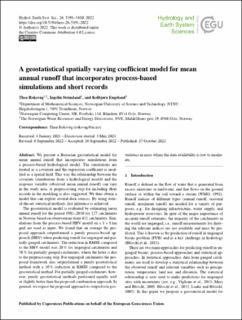| dc.contributor.author | Roksvåg, Thea | |
| dc.contributor.author | Steinsland, Ingelin | |
| dc.contributor.author | Engeland, Kolbjørn | |
| dc.date.accessioned | 2022-11-30T09:32:28Z | |
| dc.date.available | 2022-11-30T09:32:28Z | |
| dc.date.created | 2022-11-15T13:14:30Z | |
| dc.date.issued | 2022 | |
| dc.identifier.citation | Hydrology and Earth System Sciences. 2022, 26, 5391-5410. | en_US |
| dc.identifier.issn | 1027-5606 | |
| dc.identifier.uri | https://hdl.handle.net/11250/3034948 | |
| dc.description.abstract | We present a Bayesian geostatistical model for mean annual runoff that incorporates simulations from a process-based hydrological model. The simulations are treated as a covariate and the regression coefficient is modeled as a spatial field. This way the relationship between the covariate (simulations from a hydrological model) and the response variable (observed mean annual runoff) can vary in the study area. A preprocessing step for including short records in the modeling is also suggested. We thus obtain a model that can exploit several data sources. By using state-of-the-art statistical methods, fast inference is achieved.
The geostatistical model is evaluated by estimating mean annual runoff for the period 1981–2010 for 127 catchments in Norway based on observations from 411 catchments. Simulations from the process-based HBV model on a 1×1 km grid are used as input. We found that on average the proposed approach outperformed a purely process-based approach (HBV) when predicting runoff for ungauged and partially gauged catchments. The reduction in RMSE compared to the HBV model was 20 % for ungauged catchments and 58 % for partially gauged catchments, where the latter is due to the preprocessing step. For ungauged catchments the proposed framework also outperformed a purely geostatistical method with a 10 % reduction in RMSE compared to the geostatistical method. For partially gauged catchments, however, purely geostatistical methods performed equally well or slightly better than the proposed combination approach. In general, we expect the proposed approach to outperform geostatistics in areas where the data availability is low to moderate. | en_US |
| dc.language.iso | eng | en_US |
| dc.publisher | European Geosciences Union | en_US |
| dc.rights | Navngivelse 4.0 Internasjonal | * |
| dc.rights.uri | http://creativecommons.org/licenses/by/4.0/deed.no | * |
| dc.subject | Romlig statistikk | en_US |
| dc.subject | Spatial statistics | en_US |
| dc.subject | Avrenning | en_US |
| dc.subject | Runoff | en_US |
| dc.subject | Bayesiansk statistikk | en_US |
| dc.subject | Bayesian statistics | en_US |
| dc.subject | Hydrologi | en_US |
| dc.subject | Hydrology | en_US |
| dc.title | A geostatistical spatially varying coefficient model for mean annual runoff that incorporates process-based simulations and short records | en_US |
| dc.title.alternative | A geostatistical spatially varying coefficient model for mean annual runoff that incorporates process-based simulations and short records | en_US |
| dc.type | Peer reviewed | en_US |
| dc.type | Journal article | en_US |
| dc.description.version | publishedVersion | en_US |
| dc.source.pagenumber | 5391-5410 | en_US |
| dc.source.volume | 26 | en_US |
| dc.source.journal | Hydrology and Earth System Sciences | en_US |
| dc.identifier.doi | 10.5194/hess-26-5391-2022 | |
| dc.identifier.cristin | 2074217 | |
| dc.relation.project | Norges forskningsråd: 250362 | en_US |
| cristin.ispublished | true | |
| cristin.fulltext | original | |
| cristin.qualitycode | 2 | |

